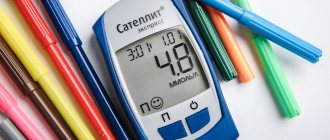Because the symptoms of diabetes can go undetected for significant periods of time, it is called the silent killer. Detection of the disease at an early stage and timely treatment helps prevent numerous severe complications that may be associated with damage to the nervous system, kidneys, eyes, disturbances in the peripheral blood supply, as well as complications during pregnancy.
We should not forget about the prevention of diabetes, which involves, in particular, lifestyle changes. You should stop smoking, do not forget about physical activity, and a balanced healthy diet is necessary. Below are ten key early signs of diabetes that should alert you.
No. 1 Copious, frequent urination
One of the earliest symptoms of diabetes is polyuria.
If you notice frequent urination and a significant increase in urine volume (especially at night), this is a serious signal to contact a general practitioner or endocrinologist.
The amount of glucose in the blood increases due to slower absorption. As a result, the work of the kidneys increases and they “try” to remove excess glucose into the urine. Water, instead of being absorbed by the body, is intensively removed from it.
check yourself
Other symptoms of type II diabetes in men are:
- Constant thirst, dry mouth, increased volume of liquid drunk.
- Frequent urination (including at night), inflammation of the foreskin, itching in the groin.
- Deterioration of vision.
- Pressure surges.
- Long-lasting wounds.
However, the disease is often asymptomatic and discovered by chance.
Continued: Diabetes mellitus, causes and prevention →
#3 Insatiable hunger
Due to disrupted metabolic processes in the body, a person may constantly experience a feeling of hunger, as the cells stop absorbing glucose, which is “fuel” for the cells.
The body has to look for alternative sources of energy. Moreover, even consuming a large amount of food is not able to satiate a person. He is unable to satisfy his hunger, because overeating further increases the blood sugar level.
In such a situation, a visit to the endocrinologist cannot be postponed.
Main classification
Clinically significant classification consists of two main types of disease:
- symptomatic or secondary - a consequence of pathologies of the pancreas or thyroid gland, adrenal glands, pituitary gland, chronic renal failure;
- primary or true.
True pathology is classified into the following types:
- Type I is insulin-dependent - your own insulin is not produced at all or is synthesized in an insignificant amount.
- Type II or insulin-independent - body tissues are not sensitive to insulin at any concentration in the blood.
A separate group consists of pathology in pregnant women. What is important is the severity of diabetes – I, II, III – and the stage of compensation for carbohydrate metabolism disorders: compensated (well-controlled course of the disease), decompensated (complete lack of effect from treatment) or subcompensated (treatment is carried out, but it is not enough).
#9 Dry skin and itching
Elevated blood glucose levels provoke dysfunction of the sweat and sebaceous glands. Human skin becomes sensitive and dry. Due to the reduction of the skin's protective barrier, toxins, allergens and infections easily penetrate the skin. In most cases, itching is the result of dry skin or a fungal infection. In some cases, dark spots appear on the skin with diabetes (in the armpits, on the neck and in the groin area).
If you are regularly bothered by burning or itching in various parts of the body, as well as dry skin (despite moisturizing), you need to consult a specialist.
By the way
There is an opinion that people with a sweet tooth are primarily susceptible to diabetes. But in fact this is a myth. Excessive consumption of sweets does not lead to diabetes. But it can lead to obesity, and this is a real risk of developing diabetes. Therefore, it doesn’t matter what exactly a person overeats - pies and buns or sausages and pates, the result can be the same.
For prevention, every middle-aged and older person should reduce the amount of easily digestible carbohydrates and fats in their food. It is useful to eat more vegetables and unsweetened fruits, as well as foods rich in vitamins C, B, PP, E. And, of course, you should not smoke.
No. 10 Visual impairment
Is it difficult for you to see details, everything floats before your eyes and you feel like you’re in a fog, have you lost your visual acuity? These symptoms may also signal high blood sugar levels.
If such symptoms are left unattended, over time new blood vessels will appear on the retina and serious problems such as cataracts, glaucoma and retinopathy will arise.
Proper treatment and proper nutrition for diabetes of any type has a positive prognosis; the person remains able to work and does not change his usual lifestyle.
Take care of your health; if you have even one of the listed symptoms, consult a doctor!
Flexibility test
At home, you can conduct a flexibility test, the results of which can determine the presence of diabetes.
Ask your spouse to stand on the floor and try to wiggle their big toes. If each finger is able to rise 50–60° from the floor, that’s good, but if the fingers can only barely lift off the floor, then the metabolism is impaired.
Article on the topic
Fighting diabetes. What is dangerous about sugar disease and how to live with it
Let the husband put his palms together. If the fingers coincide with each other along the entire length, good. In diabetics, only the pads of the fingers are connected because their tendons are shortened.
But, of course, such tests are not comparable in diagnostic importance to blood sugar tests.
Complications of the disease
If a patient with diabetes mellitus ignores the doctor’s recommendations, does not follow a diet, or refuses to take medications, the disease can be complicated by serious pathologies and changes in the body that threaten disability and even threaten life. This:
- severe visual impairment, damage to structures inside the eyeball and its vessels;
- formation of persistent hypertension (increased blood pressure);
- lipid metabolism disorders, increased “bad” cholesterol, which leads to atherosclerosis;
- severe swelling of the limbs;
- frequent headaches that impair performance;
- sensory disturbances in the extremities (neuropathy), blood flow disorders (angiopathy).
Against the background of metabolic disorders, life-threatening conditions - coma - can occur. They develop both against the background of an increase in blood sugar, and against the background of its sharp decrease (with incorrectly selected treatment, concomitant pathologies).
Hypoglycemic coma is dangerous because it develops quite quickly and can lead to serious consequences. It occurs when glucose levels decrease to less than 2.8 mmol/l. Doctors can help with this by administering doses of glucose with individually selected insulin levels.
Ketoacidotic coma occurs when glucose metabolism is disrupted when it increases in the blood. It breaks down into ketone bodies, which poison the body. Lactate coma occurs when there are failures in glucose metabolism, against which acidic metabolic products accumulate, which leads to respiratory and circulatory disorders, and requires treatment in intensive care.
Prevention
To prevent the development of diabetes, you must:
- normalize body weight;
- constantly practice moderate physical activity, play sports, walk in the fresh air;
- switch to a healthy diet, which involves eating plenty of fruits and vegetables;
- promptly treat pancreatic diseases.
People with obesity, frequent stress, and poor diet need to be especially careful. Diabetes mellitus is also possible during pregnancy.
Diagnosis of diabetes mellitus
To get diagnosed with diabetes, you need to make an appointment with an endocrinologist. Doctors of JSC “Medicine” (clinic of academician Roitberg), which is located at 2nd Tverskoy-Yamskaya lane 10 near the Mayakovskaya, Novoslobodskaya, Chekhovskaya, Tverskaya, Belorusskaya metro stations, will study the patient’s complaints, collect anamnesis, determine risk factors, and then prescribe examinations :
- fasting blood test. Before the tests, you should not eat anything in the morning or evening. During the procedure, blood is drawn;
- blood test at any time. This is necessary to confirm the types of diabetes and its presence in general;
- Analysis of urine. Patients with any type of diabetes have high levels of glucose in their urine.
All of the above tests can be done directly at the clinic of JSC “Medicine” in the Central Administrative District of Moscow.
Medicines for type 2 diabetes in older people
In the modern world, there are a huge number of medications to combat diabetes. Drugs to stimulate insulin production, to reduce insulin resistance, to increase the excretion of glucose in the urine, to slow down the absorption of glucose in the intestines. Important! Only a doctor, based on the test results, will be able to prescribe therapy and prescribe the necessary medications. Under no circumstances should you self-medicate or change medications without permission during treatment!
A special feature of therapy for older people is that, as a rule, in addition to diabetes itself, they also have a number of chronic diseases. In this case, many medications are prescribed, and the patient’s task is to strictly follow the regimen for taking them. It is important here that the drug use regimen is simple for a diabetic, and, if possible, relatives or close people can be involved in helping to control this process.
In addition, in old age, with diabetes mellitus, there is a violation of the recognition of hypoglycemic conditions, and an important goal of treatment is the prevention of these manifestations through strict adherence to diet and daily routine.
Risk group
Diabetes can be congenital or acquired, occur in a latent form, or manifest during periods of high hormonal activity (puberty, pregnancy, menopause, etc.). If a congenital metabolic disorder in children is facilitated by a burdened heredity or a teratogenic effect on the fetus during a woman’s pregnancy, then an acquired one can occur against the background of the following diseases or conditions:
- obesity, physical inactivity;
- long-term uncontrolled use of certain medications (cytostatics, hormones, adrenaline, anticoagulants, diuretics, antihypertensive drugs);
- mental disorders, psycho-emotional instability;
- renal failure, adrenal dysfunction;
- cardiovascular failure;
- dysfunction of the liver and organs of the hepatobiliary system.
Any disease in which metabolism is disrupted, as well as emergency conditions: acute poisoning, dehydration, severe infection, viruses, can affect the development of diabetes.
Low testosterone levels
It is known that the course of diabetes mellitus in men after 45 years of age is more malignant and is accompanied by a higher frequency of complications than in women. Why does this happen in men?
It has been established that low levels of testosterone, the main male hormone, almost double the risk of developing insulin resistance and diabetes. As all men age, there is a gradual decline in testosterone production in the testicles. Every man sooner or later faces the problem of male menopause or age-related androgen deficiency and the risk of developing diabetes. But, until now, the problem of age-related androgen deficiency in Russia has not been seriously considered. A man with insulin resistance and type 2 diabetes mellitus must be examined for the level of sex hormones. If a man has low testosterone levels, then a medical andrologist will definitely offer the option of individual correction.
The mechanism of pathology development and negative factors
The pancreas is to blame for everything, producing enzymes without which fat, protein and carbohydrate metabolism is impossible. Numerous groups of cells called “islets of Langerhans” are scattered between its lobules. They perform the functions of endocrine glands. They produce hormones (glucagon, insulin) that regulate the processing of carbohydrates.
A disruption in the functioning of the immune system leads to the fact that it ceases to “recognize” the pancreas and produces antibodies against it. As a result, groups of cells in the islets of Langerhans die.
Symptoms and signs of diabetes
Patients with diabetes complain of the following symptoms:
- dry mucous membranes, thirst;
- frequent urge to urinate;
- sudden weight loss or, conversely, obesity;
- blurred vision;
- dizziness;
- the appearance of ulcers on the skin;
- deterioration in performance, frequent infectious diseases;
- insomnia, frequent fatigue, increased appetite.
If such symptoms appear (all or part of them), you must immediately visit a doctor and undergo an examination.










